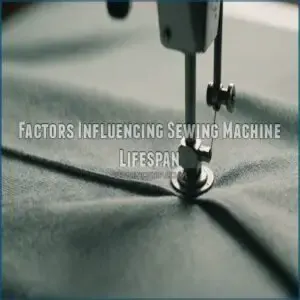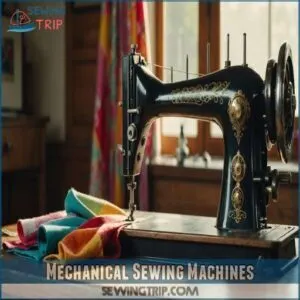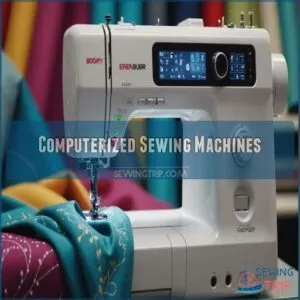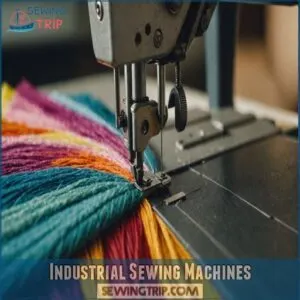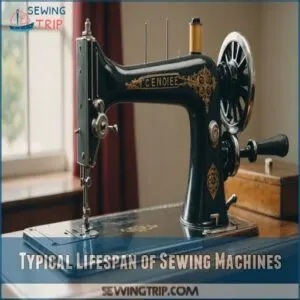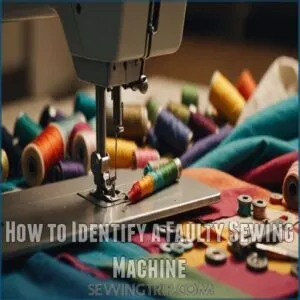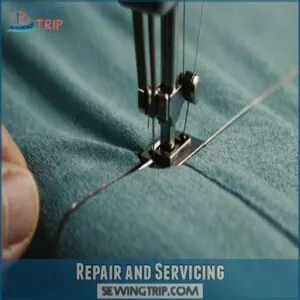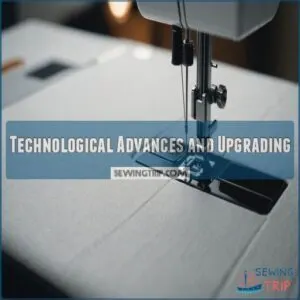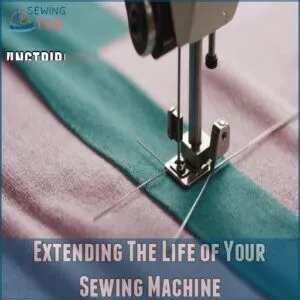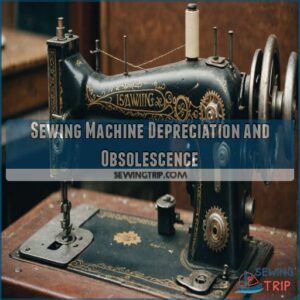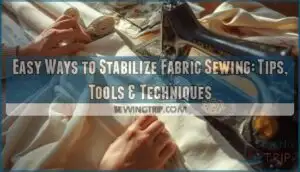This site is supported by our readers. We may earn a commission, at no cost to you, if you purchase through links.
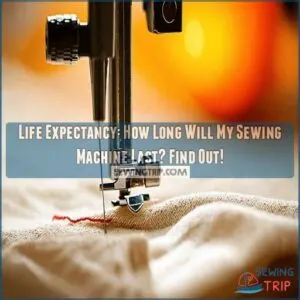 Wondering about your sewing machine’s life expectancy?
Wondering about your sewing machine’s life expectancy?
It’s like asking how long a good pair of shoes will last – it depends!
A basic machine might last 5-10 years, while a high-end computerized model could easily sew for 20+ years.
Proper care is key; regular cleaning and oiling are your machine’s best friends.
Think of it as preventative maintenance – you wouldn’t skip your car’s oil change, right?
Frequency of use plays a role too; a daily workhorse will wear out faster than a weekend hobbyist’s machine.
But don’t worry, we’ll explore factors influencing your machine’s lifespan, offering tips to extend its life far beyond expectations.
You’ll be amazed at what you can learn!
Table Of Contents
- Key Takeaways
- Factors Influencing Sewing Machine Lifespan
- Sewing Machine Types and Lifespan
- Typical Lifespan of Sewing Machines
- Signs of a Faulty Sewing Machine
- Repair and Servicing
- Technological Advances and Upgrading
- Extending The Life of Your Sewing Machine
- Sewing Machine Depreciation and Obsolescence
- Frequently Asked Questions (FAQs)
- Conclusion
Key Takeaways
- When properly maintained and serviced, a sewing machine can last for many years, with regular tasks like threading and winding the machine helping to extend its lifespan. You can expect a basic sewing machine to last 5-10 years, while a high-end model could last 20+ years.
- Regular cleaning, oiling, and proper maintenance significantly extend your machine’s lifespan.
- How often you use your machine and the intensity of its use directly impact its longevity.
- The type of sewing machine (mechanical, computerized, industrial) influences its expected lifespan, with mechanical models generally lasting longer.
Factors Influencing Sewing Machine Lifespan
So, you want to know how long your trusty sewing machine will keep stitching?
Several key factors—like its build quality, how often you use it, and how well you maintain it—all play a big role in its lifespan.
Material and Build Quality
When considering your machine’s lifespan, material and build quality are key.
Opt for metal over plastic; it’s sturdier and extends lifespan.
Appreciate the charm and strength of vintage versus modern models with their robust construction, such as those from brands like Bernina, known for their long-lasting sewing machines.
Always favor machines with durable components like solid frames, as these heavily influence build quality, ensuring your sewing machine’s durability for years to come.
Frequency of Use
Using your sewing machine daily, especially for heavy projects, impacts its durability and lifespan.
If you often tackle long projects, sewing frequency and use intensity increase wear and tear.
Imagine your machine like an athlete—constant use without rest can lead to fatigue.
Balance your sewing sessions to maintain longevity and keep your machine performing at its best!
Maintenance and Care
Just like a car needs regular check-ups, your sewing machine craves care for a long, happy life.
Imagine tackling a quilting marathon; you’ll want your machine primed to handle the fun.
Regular sewing machine cleaning, choosing the right oil types, and following lubrication tips will keep problems at bay, extending both its lifespan and your joy in use.
Type of Sewing Machine
Choosing the right type of sewing machine can greatly impact its lifespan.
Mechanical models, known for durability, might remind you of your grandma’s trusty Singer.
Computerized machines bring advanced features but require gentle handling.
Industrial machines, while more robust, suit heavy use.
Balance your needs with the machine’s capabilities to make sure your sewing companion stands the test of time.
User Habits
Your sewing machine’s lifespan hinges on your habits.
Handle it with care—avoid overloading, use the right needle, and set the correct thread tension.
Don’t race through projects at breakneck sewing speeds; your machine’s not a racecar!
Regular maintenance is key, ensuring that your trusty companion remains in top shape and ready for whatever stitching adventure lies ahead.
Sewing Machine Types and Lifespan
So, you want to know how long your sewing machine will last?
Well, the type of machine you own—whether it’s a trusty mechanical model, a whiz-bang computerized one, or a heavy-duty industrial workhorse—significantly impacts its lifespan.
Mechanical Sewing Machines
Mechanical sewing machines are your reliable workhorses, often outlasting their owners with lifespans of 20 to 30 years.
Think of a vintage model like an old friend; they demand care.
Regular maintenance—like oiling and part replacement—keeps them running smoothly.
According to some experts, vintage sewing machines are built with metal parts, making them sturdy and long-lasting, which is a key factor in their ability to last a lifetime with proper care.
Embrace their durability, but don’t ignore common issues like thread jams.
Follow a troubleshooting guide, and enjoy their longevity.
Computerized Sewing Machines
Embracing the tech-savvy world of computerized sewing machines lets you tackle embroidery with flair, thanks to advanced features like touchscreen user interfaces and software updates.
They boast a lifespan of 10-15 years when handled with care, and while troubleshooting tips are handy, regular maintenance can keep them humming smoothly.
Think of them as your trusty electronic helpers, blending creativity with durability.
Industrial Sewing Machines
Imagine industrial sewing machines as the trusty workhorses of sewing—they thrive in heavy-duty applications, ensuring sewing machine durability and reliability.
Typically, these machines boast a lifespan of 25-30 years with rigorous maintenance schedules.
You can find a wide range of reputable brands like Juki and Brother, ensuring quality and longevity.
Consider these essentials:
- Schedule regular servicing.
- Address common industrial sewing machine problems promptly.
- Embrace longevity with proper care.
Typical Lifespan of Sewing Machines
You’ve probably wondered just how long your sewing machine can keep up with your creative projects, and the answer largely depends on its type and maintenance.
On average, mechanical machines might work their magic for 20-30 years, while computerized ones often last around 10-15 years, but keep them in tip-top shape to stretch beyond these numbers!
Average Lifespan of Sewing Machines
Your trusty sewing machine’s lifespan can stretch from a decade to a whopping 30 years, depending on the type and your dedication to sewing machine maintenance, and using the right products from stores like sewing machine longevity.
Mechanical models often boast greater longevity, while computerized ones need more TLC.
For longer sewing machine life expectancy, regular care, such as cleaning and oiling, becomes your best ally.
Remember, sewing machine care pays off!
Lifespan of Specific Sewing Machine Brands
Curious about how long your machine should last?
Let’s look at popular brands: a Singer might sew strong for 20-25 years, while Brother stands out for its 10-15 year durability.
Janome‘s known for reliability with a lifespan of 25 years or more.
Bernina’s all about longevity, sometimes pushing 30 years, and Juki offers impressive performance for heavy-duty use.
Signs of a Faulty Sewing Machine
So, your sewing machine’s acting up?
Let’s explore the telltale signs that it needs some TLC, from strange noises and skipped stitches to inconsistent tension and thread jams—we’ll help you figure out what’s wrong and get your machine sewing smoothly again.
Common Issues With Sewing Machines
Imagine this: you’re happily sewing away, then suddenly, thread jams bring you to a halt.
Needle breakage and skipped stitches might become familiar foes, while bobbin problems and mysterious motor noises turn regular stitching into a riddle.
These common issues with sewing machines test patience but also affect the sewing machine lifespan if not handled with care and timely repair.
How to Identify a Faulty Sewing Machine
After recognizing common sewing machine issues, spotting a faulty machine becomes straightforward.
Listen for strange sewing machine noises or stitch problems.
Watch out for pesky thread issues and bobbin hiccups.
If the machine’s overheating unexpectedly or you see reliability slipping, it’s time to inspect further.
Frequent failures could mean higher repair costs, so keep those ears and eyes peeled!
Troubleshooting Common Sewing Machine Problems
Identifying common sewing machine problems doesn’t need to be a headache.
Troubleshoot effectively by first checking for needle problems, such as skipped stitches or jammed machines, which can often be fixed by fixing thread issues, or thread jams, which often reveal themselves through unexpected machine noise.
If your stitches are skipping or tension issues arise, these could signal a need for repair.
Regular maintenance reduces sewing machine repair frequency, extending your sewing machine lifespan with simple care tips.
Repair and Servicing
Regular repair and servicing, which typically include annual sewing machine maintenance to replace worn-out parts, are the secret ingredients to extending your sewing machine’s lifespan, much like a spa day keeps your stress in check.
You’ll want to know when it’s time to visit a technician.
How simple at-home maintenance can keep your machine humming smoothly.
When to Take Your Sewing Machine to a Technician
Is your sewing machine making unusual noises or experiencing issues that may indicate a problem with its Sewing machine timing adjustment guide, such as skipping stitches?
It’s probably time for a pro check-up.
Proper sewing machine maintenance can also go a long way in preventing these issues, and you can find products for that at sewing machine maintenance.
Here’s when to head to a technician:
- Persistent tension issues disrupting your projects.
- Stitch problems or motor problems affecting performance.
- More frequent professional servicing than usual in your maintenance schedule.
These signs don’t just whisper—sometimes they shout for help!
How to Find a Reliable Sewing Machine Repairman
Finding a reliable sewing machine repairman can feel like searching for the elusive needle in a haystack.
Start by checking online reviews and recommendations from local sewing groups; everyone’s got a story of their machine mishaps.
Make sure the repairman has solid qualifications and experience. A good reputation is key.
A qualified expert helps extend your sewing machine’s lifespan efficiently and effectively.
Maintenance Tasks to Perform at Home
Let’s keep your sewing machine purring!
Regular home maintenance is key to extending its lifespan.
Tackle these simple tasks:
- Clean the bobbin and foot regularly to prevent jams.
- Apply a drop of oil to the moving parts—it’s like a spa day for your machine!
- Replace the needle when it gets bent or dull.
These small steps make a big difference in sewing machine longevity.
Technological Advances and Upgrading
Keeping your sewing machine up with the times is like upgrading your phone—necessary yet often overlooked.
Though it mightn’t make coffee, a modern machine can save time and bring your projects to the next level with features like automated needle threading and USB connectivity.
How to Keep Your Sewing Machine Up-to-Date
To keep your sewing machine up-to-date, focus on software updates and compatibility.
Regularly check for new features that can enhance your projects.
Address any compatibility issues by upgrading accessories or parts.
Explore learning resources to stay informed.
Your machine’s lifespan thrives on sewing machine care and maintenance, prolonging its service with timely sewing machine servicing.
| Aspect | Tip |
|---|---|
| Software Updates | Check regularly |
| New Features | Explore and utilize |
| Compatibility Issues | Upgrade accessories if needed |
| Learning Resources | Stay informed |
| Maintenance | Schedule regular servicing |
Benefits of Upgrading Your Sewing Machine
Thinking about sewing machine upgrade options stirs excitement, doesn’t it?
With new technology, you can enjoy advanced features, faster speed, and enhanced durability, which greatly boost stitch quality and ease.
Upgrading could extend your sewing machine lifespan and counteract sewing machine obsolescence, saving you from costly depreciation.
So, why not embrace the changes and open up a world of creative potential?
How to Choose The Right Upgrade for Your Sewing Machine
Upgrading your sewing machine? Perfect timing! First, think about your budget and read reviews to compare the latest features.
Are you eyeing a specific brand or model? Make sure it suits your sewing machine types and usage needs.
Consider sewing machine upgrade options that fit your projects and extend your sewing machine lifespan.
With a smart choice, sewing bliss awaits!
Extending The Life of Your Sewing Machine
To keep your sewing machine running like a champ, a little TLC goes a long way.
Regular cleaning and oiling, using the right needle and thread, and storing it properly can make all the difference in extending its life.
So don’t let your trusty machine gather dust or thread jams.
Regular Cleaning and Oiling
Ever felt like your sewing machine needed a vacation?
Regular cleaning and oiling might be just the ticket to extend its lifespan!
Grab some cleaning tools and high-quality sewing machine oil, focusing on key lubrication points.
Follow your maintenance schedule religiously.
Your trusty companion will purr like a kitten, ready to tackle any project with ease and precision!
Proper Storage and Environment
To ensure your sewing machine lasts, it’s crucial to choose a model with metallic components and high stitches per minute (SPM), key considerations for home sewing machines. Keeping your sewing machine happy means giving it a good home!
After oiling, store it in a cool, dry spot.
A machine cover protects against dust and humidity impact.
Temperature control is key; avoid extreme heat or cold.
Proper sewing machine storage—like a dedicated space—extends its life.
Think of it as giving your trusty friend a comfy retirement!
These sewing machine longevity tips will keep your machine sewing beautifully for years.
Using The Correct Needle and Thread
Selecting the right needle and thread combo can extend your sewing machine’s life—really! Always match needle size to fabric type to prevent jams, considering options like universal needles for versatility or choosing the right needle for specific fabrics like knits or denim.
High thread quality prevents breakages and tension issues.
Remember, needles wear out faster than you’d think, so replace them regularly to maintain efficiency.
- Match needle size to fabric type.
- Use high-quality thread.
- Replace needles often.
Proper Threading and Tension
After getting the right needle and thread, threading your machine correctly is like setting up the pieces for a perfect sewing dance.
To avoid missteps, mastering how a sewing machine works Learn about sewing machine mechanisms is essential. Missteps lead to thread tension issues or bobbin winding disasters.
Check that your top thread flows smoothly.
Troubleshoot tension problems early to extend your sewing machine’s lifespan.
Keep threading simple, and your projects will thank you!
Sewing Machine Depreciation and Obsolescence
Just like cars, your sewing machine won’t keep its shine forever, as time and use naturally lead to depreciation.
Knowing how to calculate its depreciation value helps you make decisions about repairs or a shiny new upgrade.
Understanding Sewing Machine Depreciation
You’ve nurtured your sewing machine’s lifespan with care—now let’s chat about depreciation.
Like cars, sewing machines lose value, but understanding the depreciation rate is key.
Imagine this: your trusty machine has served you well, but its resale value drops yearly by about 15%.
Calculating depreciation helps plan for eventual replacement cost, ensuring you’re always ready for what’s next!
Factors Affecting Depreciation Rate
Have you wondered why two seemingly identical sewing machines don’t depreciate at the same rate?
Usage frequency plays a big role—machines in constant use wear faster.
Machine age and brand reputation also matter.
A well-maintained vintage Singer might hold its value due to its sturdy build.
Consider repair history and market demand too, for sewing machine lifespan insight.
How to Calculate Depreciation Value
Calculating your sewing machine’s depreciation isn’t rocket science, and it helps you keep an eye on its value.
Here’s how you do it:
- Initial Cost: Start with the purchase price.
- Depreciation Rate: Generally, about 15% per year.
- Sewing Machine Lifespan: Decide on expected years of usage.
Voila, you’ve got a clear value picture!
Frequently Asked Questions (FAQs)
How long do sewing machines typically last?
Imagine your grandma’s trusty old machine still humming along.
A mechanical sewing machine can last 20-30 years with care.
Proper maintenance and gentle use can extend its life, keeping it stitching like a champ!
How long does a Bernina Sewing Machine Last?
Your Bernina sewing machine, renowned for quality and durability, could last 20 to 30 years with proper maintenance.
Routine cleaning, oiling, and handling with care play key roles in extending its lifespan, keeping it sewing smoothly.
How long do computer-controlled sewing makers last?
Computer-controlled sewing machines typically last 10-15 years, depending on use and care.
They offer advanced features but need more maintenance than mechanical models.
Treat them right by cleaning regularly and servicing annually.
Keep them happy, they stitch better!
How do you know if a sewing machine is worth it?
Ever wonder if a sewing machine’s a wise buy?
Check build quality—metal beats plastic.
Factor in your sewing needs, number of stitches, and additional features.
Research reviews for reliability, ensuring you’re investing in a timeless crafting companion.
How to reduce the lifespan of sewing machine oil?
Store sewing machine oil improperly by exposing it to heat and light, which accelerates degradation.
Keep the container open, allowing contaminants like dust to mix in.
This speeds up oxidation, reducing its effectiveness and causing it to spoil.
Are old sewing machines worth preserving?
Like a trusty steed, a well-maintained old sewing machine, such as those made by Singer with their vintage models and serial numbers, is worth preserving.
It’s a reflection of craftsmanship, offering durability and unique charm.
Consider its condition, repair costs, and sentimental value before deciding.
What brands offer the most durable sewing machines?
You’ll find durable sewing machines from brands like Singer, Janome, and Juki.
These companies craft machines with strong metal frames and quality parts.
With proper care, their models stand up to years of heavy sewing projects.
How do environmental factors impact machine lifespan?
Did you know that humidity can affect your sewing machine’s lifespan, potentially leading to rust or mold?
Keep it in a cool, dry spot and use a dust cover to help avoid these sneaky threats.
Can improper storage affect my sewing machine?
Improper storage can harm your sewing machine by exposing it to dust and moisture, leading to rust or motor issues.
Storage is key to keeping your sewing machine in tip-top shape.
Keep it in a cool, dry place, and use a cover to protect it from damage.
Are vintage sewing machines more reliable than new ones?
Vintage sewing machines, often with metal frames, tend to be more durable than new ones with plastic parts.
While new models offer modern features, vintage ones boast longevity, making them favorites for enthusiasts valuing reliability and sturdiness.
What are common mistakes that shorten lifespan?
Let’s avoid stitching mistakes by sidestepping these pitfalls: skipping regular cleaning, ignoring tension settings, using low-quality thread, overloading your machine, and forgetting timely oiling.
Keep your sewing powerhouse happy and it’ll serve you well!
Conclusion
Worried your sewing machine won’t last? Don’t fret! With the right care, your machine’s life expectancy can surpass any worries about premature failure.
By understanding factors like usage frequency and maintenance, you can keep it humming far beyond its average lifespan.
Think of it like caring for a good friendship—regular attention and little tune-ups go a long way.
Whether it’s a basic or high-tech model, keep the threads of maintenance tight, and you’ll sew happily for years.

